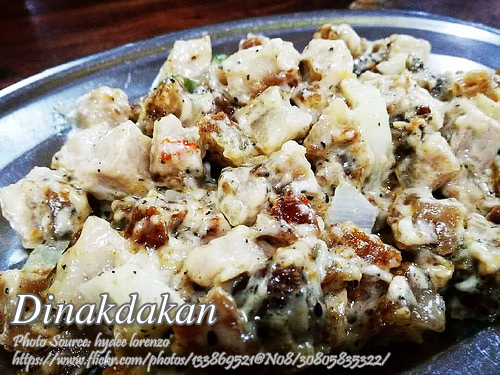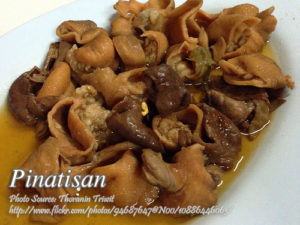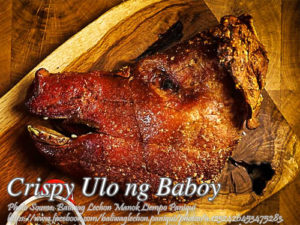Dinakdakan originated in the Ilokos region in the Philippines and in my opinion is an Ilokano version of sisig, a pork dish originated in Pampanga. The only difference is the additional ingredient which is the pork brain but some other version uses only mayonnaise to make it creamy. The pork parts used in dinakdakan is usually pork mask, nape, ears, intestines and liver but you can also use pork belly just like the sisig version. In this recipe only pork mask and ears are used because it is laborious cleaning the pig’s intestines. This is just to make the dish as simple as possible but savory and close to the authentic Ilokano dish.
Dinakdakan: A Flavorful Memory
I still remember the first time I tasted the dish. It was at my cousin Rico’s house in La Union, where his family gathered to celebrate his graduation. There, amid the joyful chaos of relatives catching up, my Auntie Lita brought out a sizzling platter of this mouthwatering Ilokano dish. One bite, and I was hooked—its smoky, creamy, and savory flavors were unforgettable.
A Taste of Ilocos: What is Dinakdakan?
Dinakdakan hails from the Ilocos region in the northern Philippines, where pork dishes are a staple. Some might say it’s the Ilokano counterpart of the famous Kapampangan sisig. While both dishes are similar in using various pork parts and having a rich, savory flavor, it stands out because of one special ingredient—pork brain. This addition gives it a creamy, slightly sticky texture that sets it apart. However, in some modern versions, mayonnaise is used instead, making the dish more accessible to those who might feel uneasy about pork brain.
The traditional version uses pork mask, ears, nape, intestines, and liver. But let’s be honest—cleaning intestines can be a chore. That’s why in this version, I stick to the basics: pork mask and ears. It’s simpler, but it still hits all the right notes.
A Family Favorite: Cooking Dinakdakan
Cooking Dinakdakan is an art, and my Uncle Eddie swears by his method of boiling the pork mask and ears first. This ensures the meat is tender before it hits the grill. The boiling process takes about 30 to 40 minutes, just enough to soften the pork without losing its texture. After that, the meat gets grilled to a perfect char, enhancing its smoky flavor.
I learned from my Auntie that grilling is crucial. It not only adds flavor but also gives the dish that satisfying crispiness. Whether you’re using a stovetop grill or a non-stick pan, make sure to render the fat properly until it turns brown and crispy. Slice it into strips after grilling—it’s easier and less messy this way.
The Secret Creaminess
One of the secrets to a good dinakdakan is achieving that perfect creaminess. Traditionally, pork brain is used, giving it an authentic taste and texture. But not everyone has access to or is comfortable using pork brain, so mayonnaise has become a popular alternative. I remember when my sister Lani first tried to cook dinakdakan, she hesitated about using brain. Uncle Eddie reassured her, saying, “Don’t worry, mayo works just fine.” And he was right. The result was just as creamy and satisfying.
If you decide to stick to tradition, here’s how you do it: sauté the pork brain with a little salt and pepper until it reaches a paste-like consistency. This step helps remove any metallic taste while bringing out the creaminess. Once cooked, it’s combined with the grilled pork, vinegar, calamansi juice, and spices to balance the richness with acidity.
A Bold and Flavorful Mix
The final step is combining everything. In a mixing bowl, the grilled pork strips are tossed with thinly sliced onions, bird’s eye chili, green pepper, ginger, and a splash of calamansi juice. The vinegar, sugar, and a touch of salt and pepper round off the flavor. I always taste as I go—my Lola used to say, “The right taste comes from your gut.”
Once everything is mixed, let it sit for a few minutes. This resting time allows the flavors to meld. Before serving, garnish with spring onions for a fresh, vibrant touch. The result is a dish that’s rich, savory, slightly tangy, and has just the right amount of spice.
A Dish That Brings Memories
To me, it isn’t just food; it’s a connection to family and heritage. Every time I prepare it, I remember those family gatherings, where stories and laughter flowed as freely as the food. The smoky aroma and bold flavors remind me of the Ilokano roots that ground me, no matter where I am.
Whether you’re making it the traditional way or opting for the mayonnaise version, one thing is for sure—Dinakdakan is more than just a dish. It’s a taste of home, a celebration of Ilokano pride, and a recipe that deserves a place on your table. Give it a try, and you might just fall in love with it the way I did.
How to Cook Dinakdakan
Ingredients
- 1 kilo pork mask with ears wash and remove hairs
- 1/4 kilo pork brain
- 1 pc white onion sliced
- 1 Tbsp. ginger minced
- 3 pcs bird's eye chili peppers chopped
- 1 pc green pepper siling haba, sliced diagonally
- 1/4 cup cane vinegar preferably sukang Iloko
- salt and pepper to taste
- 1/4 cup mayonnaise
- 4 pcs calamansi extract the juice
- 1 tsp. sugar
Instructions
How to cook Dinakdakan:
- In a pot, put the face mask and ear and pour water just enough to cover the pork, more or less 7 cups. Season with salt and pepper and bring to a boil. Simmer until fork tender, about 30 to 40 minutes.
- Slice the pork mask and ears and grill it in a stove top grill or a non-stick pan until the fat is rendered and becomes brown crispy. Slice into strips and put into a bowl. Set aside.
- In a separate bowl, mix the onion, bird's eye chili peppers, green pepper, onion, ginger, mayonnaise, calamansi juice, vinegar, sugar, salt and pepper. Mix thoroughly and set aside.
- Heat and empty non-stick pan and saute the pork brain. Season with salt and pepper and stir until cooked and becomes a paste like consistency. Remove from the pan and put it on the bowl on top of the sliced pork mask.
- Pour the mixture of vinegar and spices on the sliced pork mask and toss until the mixture is evenly distributed with the pork.
- Season again with salt and pepper to adjust the taste. Garnish with spring onions.
Notes
Cooking Tips:
Tenderize the Pork for Perfect Texture
Boiling the pork mask and ears before grilling is essential for achieving a tender and chewy texture. Simmer for about 30 to 40 minutes, just enough to soften the meat without making it mushy. This step helps the pork absorb the flavors while keeping it firm for grilling.Grill for Smoky Goodness
Grilling the boiled pork mask and ears adds a smoky flavor and gives the dish a slightly crispy texture. Make sure the fat is rendered and the surface is lightly charred to enhance the taste. Use a stovetop grill or a non-stick pan for convenience, and don’t skip this step for that authentic experience.Achieve Creaminess with Balance
Whether you use pork brain or mayonnaise, balance the creaminess with the acidity from vinegar and calamansi juice. This contrast prevents the dish from being overly rich while highlighting the bold flavors. Taste as you go and adjust to your preference to get that signature flavor.





